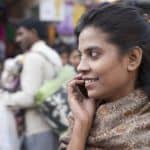The Power of Trust in Digital Finance: How to Leverage Trusted Technology to Maximize Inclusion and Impact
For more than 50 years, trust has been a key element of Opportunity International’s work to empower people around the world with financial services, training and support so they can work their way out of poverty. In our earliest days, we built trust by establishing and growing microfinance institutions (MFIs) rooted in one-on-one relationships with our loan clients. As we grew, we launched Trust Groups—peer networks in which women in a group would guarantee each other’s loans and pay the loan of members who might default. And today, as we seek to scale existing programs, launch new ones and increase opportunities for the most marginalized, trust is even more central to our success. It’s especially essential when it comes to technological solutions designed to improve the lives of those living in extreme poverty—who often earn around US $2 per day.
Trust can be a significant barrier to engagement in digital financial services among these low-income users—particularly women, who often exhibit a higher lack of trust in the banking system and in digital tools. Providers must often take measures to address this trust deficit when developing digital financial services that target women customers. For instance, after a recent study carried out by Opportunity and one of our partnering MFIs found that women are less likely to have confidence in digital systems than men, the MFI built a campaign aimed at building trust among women, to improve their registration and active use of its mobile banking platform.
When Opportunity International is designing and delivering digital financial services for our customers, trust is one of the four key elements we prioritize, which include: high-trust, high-touch, high-tech and high-impact. First, we build trust with clients through relationships, honest business practices and transparency. We work with existing trusted partners to develop new technologies, and we operate with the utmost integrity to ensure that clients feel confident in their interactions with us. Because we know that technology often comes with a steep learning curve, our work is also high-touch—reliant on peer-to-peer and staff-to-peer relationships to answer questions, provide training and support users as they familiarize themselves with new tools. We leverage high-tech approaches, ensuring that we’re using the best tools available to provide simple, effective solutions to those who need them most. Combined, these three elements lead to high impact, helping us to narrow the digital divide and increase access to and use of the financial tools people need to move out of extreme poverty.
According to the World Economic Forum, 2.9 billion people lack opportunities to access the internet and engage with the digital economy. This digital divide is at the center of the Trusted Tech Microfinance Initiative, a partnership announced this spring between Opportunity and the Krach Institute, which aims to leverage the transformative power of trust to reduce this gap in low-income countries. The partnership will use trusted technology that is safe and reliable to help ensure that financially excluded people at the bottom of the global economic pyramid have access to the best technology products, online education and training. Through this initiative, we hope to develop digital products and services that will enable micro and small businesses in emerging economies to operate more efficiently and achieve better business outcomes, which will enhance the quality of life of these entrepreneurs and their families.
Below, I’ll explore how Opportunity International is designing this initiative to build clients’ trust in the technologies we’re using – and thereby maximize the positive impact of these products.
Using Human-Centered Design and Reducing the Cost to Serve
When it comes to developing trusted technology that can bridge the digital divide, we focus on two concepts that ensure that people living in poverty have access to products and services tailored to their needs and budgets.
The first and most important concept is human-centered design—a technique that puts real people at the center of the product design process. This approach helps us determine how we can best serve the world’s most impoverished people in new ways, using new capabilities. To gain their trust, technology solutions need to address real challenges faced by people living in poverty. By following this strategy, we’ll ensure that these customers can gain access to and use the technologies we’re designing, and that these products serve their actual needs.
The second concept we’re exploring is the cost to serve. For people living in poverty to gain access to – and build trust in – technology solutions, they must be affordable, both at the client and institutional level. When tech solutions reduce the cost to serve people living in poverty, those solutions can be offered at a lower price and scaled to their benefit.
We believe that combining these two concepts in our tech development efforts will help improve the lives of many people living in poverty. Utilizing human-centered design will ensure that the technologies we develop actually address problems – or enable them to take advantage of opportunities – that they encounter in their daily lives. And reducing the cost and improving the efficiency of service delivery will ensure that these technologies are available and affordable to enough people to make a real impact. We are not interested in innovation for the sake of innovation—instead, we’re using innovation to increase incomes and break the cycle of poverty.
Six Key Areas for Developing Trusted Technology Innovation
As we develop our Trusted Technology Microfinance Initiative, we are focused on six key areas of purposeful innovation:
- Digitizing the financial life of the customer: How can we help clients gain access to a bank account or digital wallet, or make payments more effectively and safely? What role should biometrics play in establishing clients’ digital identities and building their trust? How can we utilize new approaches like WhatsApp banking? In the current brick-and-mortar-based system used by Opportunity’s MFI partners, there are countless hidden and not-so-hidden costs associated with savings, loans, insurance and payments. Our goal is to use digital tools to increase access and reduce costs across all aspects of peoples’ financial lives.
- Delivering trusted skill-building solutions efficiently and effectively at scale: The magic of technology is that it allows us to scale trusted products or initiatives rapidly, effectively and at low cost. This scale can also be applied to training. For example, we’ve massively scaled two platforms recently: one that offers an app-based training program to smallholder farmers, and another that brings tablet-based training to teachers at affordable private schools, through a partnership with Chalkboard.
- Improving horizontal communication between communities: For families living in extreme poverty, the strongest safety net they have is each other. Urbanization has frayed that safety net, so one question we’ve focused on is: How do you use technology to improve connectivity and rebuild that trust? For instance, WhatsApp has become an important communication tool in low-income communities, and throughout the pandemic, creative uses of WhatsApp and other social media platforms were developed to build relationships, like Facebook Lite groups for teachers and WhatsApp groups for schools. Opportunity and our MFI partners are leveraging these new tools, exploring the use of WhatsApp to facilitate chatbot conversations and other banking interactions with customers.
- Building groups—and making them better: When we first launched Trust Groups, the technology we used consisted of a lock box in the center of the circle where group members sat. Now we’re exploring ways to take these savings groups to the next level, using digital tools to reduce risk or move money more easily between group members via a shared account into which members can deposit their savings. This will require us to partner with a bank, which will then be able to provide loans to the group members if the need arises. Increasing Trust Groups’ transparency through this sort of digital solution will help build trust between group members – while creating a path toward greater formal financial inclusion.
- Building a trusted network: In our current technological landscape, people everywhere are used to getting information from other people and institutions we trust. Just think of how we interact with e-commerce sites like Amazon—we trust the information that is there, and we trust that when we make a purchase, it will be delivered to us. With the clients Opportunity serves, we want to be that trusted partner – the network to which they turn for information. If a farmer seeks to learn how to plant a new crop, they can turn to us. If a parent needs to find the best school for their child, we can be a trusted source for that information.
- Leveraging data: If we’re successful in the first five steps above, we will have access to a substantial amount of customer data. It is incumbent on us to use this data effectively and ethically. Our number one priority is to do no harm, but our second priority is equally important: to maximize the good. As we continue to improve financial access, training and quality of life among our clients, how can we use data to design new trusted products and services that actually improve the situation for millions of families living in poverty? This question will guide our efforts, as we work to use the information we learn from customers to develop products and services that meet their evolving needs.
As we look to the future, we will continue to build solutions that improve our clients’ lives – and that build their trust in Opportunity and our products and services. As we build more solutions that reduce extreme poverty through tech-driven innovation, we’re aiming for high impact—and we know that high-trust, high-touch and high-tech approaches will get us there.
If you would like to learn more about Opportunity International’s work in digital financial services, you can contact me at wderban@opportunity.org.
William Derban is the Global Director of Digital Financial Services for Opportunity International.
Photo courtesy of Riaz Jahanpour for USAID Tanzania / Digital Development Communications.
- Categories
- Finance, Technology, Telecommunications



